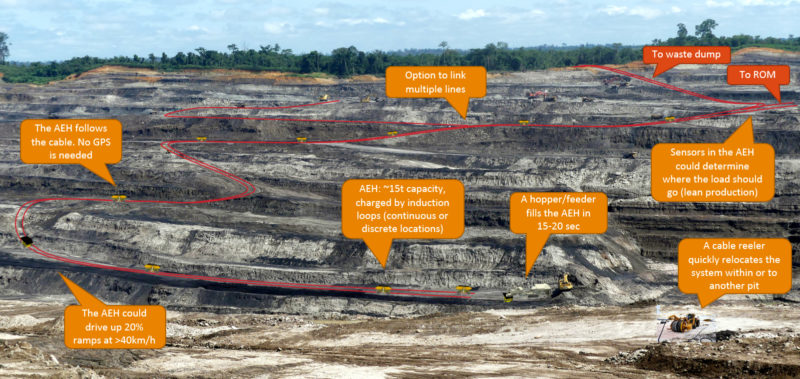Autonomous electric hauler system
Challenge
Conventional truck haulage is failing to address major issues facing the industry, such as:
- Growing cost of fuel, maintenance and capital
- Increasing strip ratios in open pit mines (in part determined by truck limits on haul road design, such as maximum slope and width)
- Challenging tunnel designs and costs for deep underground mines, where haul road widths meet geotechnical limits
- Addressing environmental and social challenges, such as: air quality (emissions), dust, noise, water consumption, and energy efficiency.
Autonomous trucks may reduce some operating costs through the decrease in labour and increased utilisation, however, they don’t address the issues of social licence.
The use of conveyors offers several advantages over conventional truck haulage, however, they also have their downfalls and limitations.
In recent years there has been a growing number of investments by mining companies and suppliers in battery-electric vehicles, such as haul trucks and LHDs particularly for underground mines, somewhat spurred on by the development in battery and electric technology. However, mining is a 24×7 operation which is highlighting the current limitations in battery technology, such as energy density, the longevity of operation, capital cost, and thermal performance.
Research
Mining3 is working on a novel material transportation system for mining operations. The system is based on small (potentially, 15t capacity) autonomous electric haulers that are powered by an electrical storage system and, most importantly, recharged via a wireless power system buried along the haul road. The system provides the flexibility of haul trucks, the efficiency of conveyors, and overcomes the limitations of battery-only solutions. Being light and small, the concept trucks also allow future haul road designs to be much steeper (20%), and narrower (10-11m), which could significantly change pit designs and improve mining costs.
Benefits
Using typical Australian mining costs for labour, fuel, and power, a preliminary economic analysis, looking solely at the cost savings, indicated that a fleet of small, induction powered, autonomous haulers would be about 25% lower in cost to operate, including capital and operating costs. The savings come from a reduction in maintenance, energy, and labour costs. The analysis did not take into consideration other potential savings from moving to smaller haulers, such as reducing the refuelling infrastructure for trucks, and less expensive maintenance tools, cranes, and sheds or hangers, which can add a lot of additional expenses.
Availability of the autonomous trucks is also expected to be higher than conventional trucks as they do not have diesel engines and complex transmissions, nor do they require operator changeovers, re-fuelling, or time-consuming maintenance procedures. The wireless induction charging system allows for continuous operation of the electric haulers.
Using smaller haulers that can drive up steeper ramps allows for deeper mines within given lease boundaries. Assuming geotechnical factors allow, a new ramp design opens up pits for extracting minerals below the limit of larger trucks. For example, analysis of a small satellite pit indicated a 23% increase in resource utilisation over the design using conventional 90t-class trucks. Using our concept smaller haulers would yield an additional $2.5M in value out of the resource. This additional benefit is without further re-optimisation of the pit shell based on in the lower cost of mining using these smaller haulers.
Status
The argument for smaller, lighter, autonomous, electric-powered haulage systems in mining operations appears compelling. Detailed design work and prototyping planned for 2019 at Mining3 will help validate initial assumptions made.
Further industry engagement is welcome to identify potential issues and improvements that will enhance the development and adaptability of this concept into a range of mining operations.
Contact Erik Isokangas, Program Director of Mining3 for further information: eisokangas@mining3.com
Factsheet
Access the latest Autonomous Electric Haulage factsheet.












